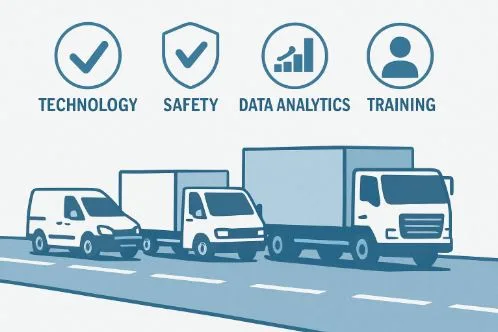How Proven Safety Strategies Shape the Future of Fleet Management
Key Takeaways
- Effective safety strategies reduce accidents and fleet operating costs.
- Driver behavior monitoring and training are critical components in modern fleet safety programs.
- Data-driven insights help organizations spot risks early and take preventative action.
- Technology is reshaping traditional approaches to fleet safety and compliance.
- Investing in a safety-first culture can yield long-term benefits, including improved morale and reputation.
Table of Contents
- The Current Landscape of Fleet Safety
- The Role of Driver Training and Behavior Monitoring
- Adopting Technological Solutions for Safer Fleets
- Analyzing Incident Data and Trends
- Developing a Fleet Safety Culture
- Leadership and Accountability in Fleet Safety
- Looking Ahead: The Future of Fleet Safety
- Frequently Asked Questions
The Current Landscape of Fleet Safety
Maintaining a safe fleet in today’s dynamic business environment is more challenging and essential than ever. Increased road congestion, the complexities of compliance, and rapidly changing technology all converge to create a landscape where risk is ever-present. Reports from the National Highway Traffic Safety Administration (NHTSA) highlight that motor vehicle crashes are among the leading causes of work-related fatalities in the U.S. This fact reinforces the urgent need for organizations to adopt robust fleet safety programs that safeguard their people and assets.
Implementing comprehensive fleet safety programs can help organizations proactively address risks, reduce accident rates, and control operating costs. These programs are the backbone of regulatory compliance, supporting not only driver well-being but also the company’s reputation and bottom line. As fleets expand and transportation demands rise, prioritizing safety through strategic planning and proactive management will become increasingly essential.
The Role of Driver Training and Behavior Monitoring
A well-trained driver is a company’s most effective defense against accidents and liability. Today’s leading fleets supplement traditional training with digital coursework, practical simulations, and periodic assessments. Real-time driver behavior monitoring has emerged as an industry standard, tracking metrics like speed, harsh braking, and device use while behind the wheel. These insights allow fleets to identify risky patterns early and tailor coaching to individual needs.
Real-world case studies prove the benefits of coupling training with monitoring. For instance, according to Commercial Carrier Journal, fleets investing in data-driven coaching often see a significant reduction in preventable incidents. Ensuring drivers remain aware of their habits—and are recognized for safe performance—helps build lasting improvement.
Adopting Technological Solutions for Safer Fleets
The adoption of new technology is revolutionizing fleet safety management. Telematics platforms, AI-powered dash cams, and connected vehicle systems deliver a constant stream of actionable data. These tools provide immediate feedback to drivers about unsafe practices and generate detailed analytics for managers to review. As explained in a recent feature on driver culture in Heavy Duty Trucking, the intersection of technology and training is where real long-term improvements take root.
Analyzing Incident Data and Trends
Harnessing the power of incident data is now essential for effective risk management. Safety leaders can spot recurring hazards related to time of day, location, weather, and driver habits by reviewing accident reports, near-miss events, and routine telematics alerts. Pinpointing these risk factors enables the development of targeted interventions, such as route adjustments or season-specific training refreshers. Data-driven strategies create benchmarks—like reductions in harsh braking events or collision frequency—and facilitate a culture of continuous improvement.
Developing a Fleet Safety Culture
Cultivating a genuine safety culture requires commitment from every level of an organization. It’s not enough to meet legal requirements; fleets must inspire trust, participation, and a shared sense of responsibility among all team members. Regular safety briefings, transparent communication channels, and recognizing safe driving achievements are all crucial. Safety becomes deeply ingrained in daily routines when employees feel empowered to speak up and know their feedback matters.
Leadership and Accountability in Fleet Safety
Effective safety initiatives are championed from the top down. Leaders set the tone, modeling responsible driving behaviors and ensuring policies are clearly defined and fairly enforced. A culture of accountability starts with transparent performance reviews, tools for anonymous risk reporting, and consistent enforcement of safety standards. Leadership’s active involvement sends a clear message—safe operations are a non-negotiable priority throughout the fleet.
Looking Ahead: The Future of Fleet Safety
New advances like predictive analytics and even autonomous vehicles will reshape fleet safety practices as the industry innovates. The ability to predict risk, rather than respond to it, will empower companies to stay ahead of evolving hazards. Industry experts anticipate that sharing data between fleets and organizations will yield additional insights and best practices. Staying informed through reputable research, such as from the Forbes Technology Council, will be paramount to guiding continuous improvement and future-proofing safety strategies.
Frequently Asked Questions
- What is the most effective driver training method? Combining classroom instruction with real-life simulations and ongoing feedback is widely regarded as a best practice for fleet safety.
- How can data analytics improve fleet safety? Analytics enable leaders to spot high-risk patterns, monitor individual performance, and track progress over time, allowing continuous safety improvements.
- Is technology replacing traditional safety programs? Technology is an enabler, but human oversight, culture, and leadership remain fundamental to any comprehensive fleet safety approach.
Prioritizing safety strategies ensures fleets remain efficient, compliant, and prepared for the challenges of tomorrow’s roads. By blending technology, training, and proactive risk management, organizations protect drivers, reduce costs, and build long-term trust. A strong safety culture safeguards assets and drives lasting operational success.





